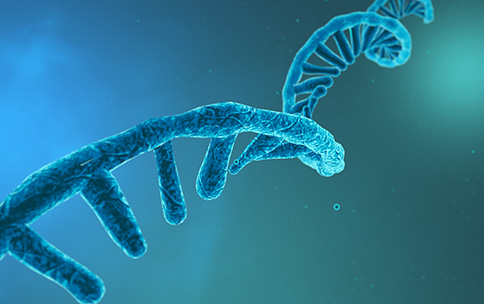
For the Common Fund’s 4D Nucleome (4DN) program, understanding the three-dimensional organization of the cell’s nucleus in space and time isn’t limited to studies of our genetic material, DNA. Other biomolecules, such as RNA and protein, play important roles in nuclear structure and function, including gene regulation. While previous studies have found distinct structural compartments within the nucleus, the full spectrum of these structures and their effect on nuclear function are still unknown. For researchers studying RNA, questions remain regarding whether RNA molecules contribute to these structural compartments, where in the nucleus they contribute, and by what mechanisms. Previous studies suggest that a particular type of RNA that does not encode directions for making proteins, called non-coding RNA (ncRNA), plays an important role in gene regulation and nuclear structure. However, a lack of methods to measure interactions between RNA and DNA in three-dimensional space has made this difficult to demonstrate.
A 4DN research team, led by Dr. Mitchell Guttman, helped scientists study RNA’s role in nuclear organization through a new method, RD-SPRITE (RNA & DNA Split-Pool Recognition of Interactions by Tag Extension). RD-SPRITE generates three-dimensional maps of DNA like its predecessor, SPRITE, but improves the sensitivity for mapping the location of thousands of nuclear RNAs. For the first time, the researchers showed that ncRNAs in the nuclei of mouse cells can act as “seeds” that drive localization of other ncRNAs and protein molecules to specific locations within the nucleus. Through this “seeding,” ncRNAs can contribute to the formation of nuclear compartments. This discovery uncovers a new role for RNA in nuclear organization and functions such as gene regulation. While this study focused on using RD-SPRITE to understand the role of ncRNAs, the method has future applications in understanding the roles of other types of RNA in nuclear organization and function.
References
- RNA promotes the formation of spatial compartments in the nucleus. Quinodoz SA, Jachowicz JW, Bhat P, Ollikainen N, Banerjee AK, Goronzy IN, Blanco MR, Chovanec P, Chow A, Markaki Y, Thai J, Plath K, Guttman M. Cell, 2021 Nov 11;184(23):5775-5790.e30. doi 10.1016/j.cell.2021.10.014. Epub 2021 Nov 4.
- Higher-Order Inter-chromosomal Hubs Shape 3D Genome Organization in the Nucleus. Quinodoz SA, Ollikainen N, Tabak B, Palla A, Schmidt JM, Detmar E, Lai MM, Shishkin AA, Bhat P, Takei Y, Trinh V, Aznauryan E, Russell P, Cheng C, Jovanovic M, Chow A, Cai L, McDonel P, Garber M, Guttman M. Cell, 2018 July 26;174(3):744-757.e24. doi: 10.1016/j.cell.2018.05.024. Epub 2018 Jun 7.


